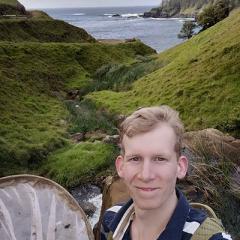Some of you may recognise this beetle from the media coverage it has received since publication of our paper in March. I was lucky enough to literally stumble upon this species while camping at Binna Burra Lodge in Lamington National Park back in 2021.
I knew it was something special, but it wasn’t until I got back to Brisbane that I began to realise just how unique this find was. I reached out to Australia’s leading longhorn beetle expert, Dr Adam Ślipiński from the Australian National Insect Collection (ANIC), and he confirmed he’d also never seen anything like it. A trip down to ANIC to work with Adam and Dr Lauren Ashman (also an expert on Australian longhorn beetles) solidified that we not only had a new species, but a new genus as well!
The discovery of a new longhorn within Australia is hardly surprising, with many undescribed species, and even genera, known to exist within entomological collections.
However, the fact that this highly conspicuous species has avoided attention for so long is something of a mystery. As far as we are aware, the holotype is the only specimen ever collected. Evidently, some aspect(s) of the behaviour, biology, phenology, ecology or distribution of Excastra albopilosa limits collection opportunities, but until additional specimens are found, it is difficult to say what that may be.
The long white hairs that cover much of the body of E. albopilosa are suspected to help the specimen mimic an insect infected and killed by an entomopathogenic fungi. Now that people are aware of this species, hopefully additional specimens and occurrence records can be documented and we can begin to learn more about it.
It has taken a couple of years for me to submit the paper, as I’ve juggled working on it with my PhD as well as numerous other side projects, but it was finally published a couple of months ago in the Australian Journal of Taxonomy. The media coverage has far exceeded my expectations, with outlets around the world picking up the story. It is great to see insects and taxonomy feature in the media!
From a conservation perspective, discoveries like this emphasise just how important it is to protect natural areas, not only for known threatened species, but also for the thousands of as-yet undiscovered species.
Such discoveries also emphasise the importance of taxonomy, which is an often underappreciated science but vitally important to many aspects of conservation. Undescribed species tend to slip through the gaps in conservation efforts (e.g., they can’t be listed on the IUCN Red List except under exceptional circumstances). Naming and describing a species, and publicly advertising the discovery, therefore ensures it is visible not only to fellow scientists but also to conservationists, policy-makers and the public, greatly reducing the risk of them being overlooked. To paraphrase David Attenborough: “no one will protect what they don't care about; and no one will care about what they have never experienced [never new existed]”.

Photo credit: James Tweed
Reference: Tweed, J.M.H., Ashman, L.G., & Ślipińksi, A. (2024). Excastra albopilosa, a remarkable new genuse and species of Lamiinae (Insecta: Coleoptera: Cerambycidae) from southeastern Queensland, Australia. Australian Journal of Taxonomy, 54: 1-8. https://doi.org/10.54102/ajt.iv1x5
Media Explore some of James’s media stories: an ABC news article here, an Australian Geographic article here, and a UQ News piece here.
Read more of these stories in Issue 18 of the CBCS Newsletter and follow us on X (Twitter) and LinkedIn.

